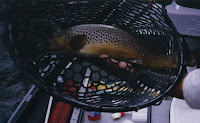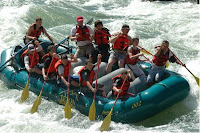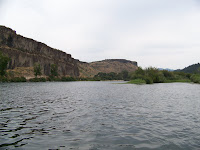 them camping each year on the Green River below Flaming Gorge. I would take Karen and Madison for a couple of days and then take David and Garrison on a separate trip. We would rent a raft from Flaming Gorge Lodge and camp at Dripping Springs, a public camping spot along the road to Big Hole. Sometimes we would hike down to the first camping spot along the B section. Floating the river in the raft we would stop along promising looking sections to
them camping each year on the Green River below Flaming Gorge. I would take Karen and Madison for a couple of days and then take David and Garrison on a separate trip. We would rent a raft from Flaming Gorge Lodge and camp at Dripping Springs, a public camping spot along the road to Big Hole. Sometimes we would hike down to the first camping spot along the B section. Floating the river in the raft we would stop along promising looking sections to  fish. Right below Mother-in-Law Rapids would always be a favorite spot where we would catch a lot. While camping, we would usually roast hot dogs and marshmallows. With the boys, we would pee off the cliffs and the usual things that boys will do.
fish. Right below Mother-in-Law Rapids would always be a favorite spot where we would catch a lot. While camping, we would usually roast hot dogs and marshmallows. With the boys, we would pee off the cliffs and the usual things that boys will do.Fishing always seemed pretty good, although the weather is quite hot in the summers. To combat the heat,
 I would always take the kids to the lodge to buy huge ice cream cones.
I would always take the kids to the lodge to buy huge ice cream cones.So on one particular trip on the way home, I asked the boys what their favorite part of the trip was. Gary immediately blurts out – stopping at the 7-11 for candy as we left. OK, I spend three days with the boys rafting down the river, fishing and camping out. Their favorite part of the trip was in the first ten minutes – stopping at the store?














